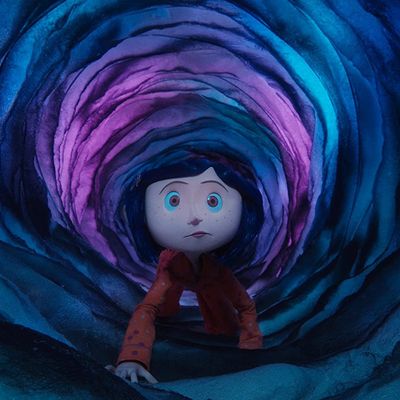
Every week for the foreseeable future, Vulture will be selecting one film to watch as part of our Friday Night Movie Club. This week’s selection — the second in a special, monthlong celebration of horror — comes from writer Rebecca Alter, who will begin her screening of Coraline on October 9 at 7 p.m. ET. Head to Vulture’s Twitter to catch her live commentary, and look ahead at next week’s movie here.
What is it about horror movies and mothers? There’s Mother!, Ma, Mama, and Goodnight Mommy. There’s The Babadook and Hereditary and Rosemary’s Baby. There’s Mommie Dearest, which is absolutely a horror film. And there’s Coraline, the 2009 Henry Selick stop-motion film about a plucky heroine named Coraline Jones who must choose between her humdrum everyday life and a plussed-up parallel world handcrafted just for her by the mysterious Other Mother.
Coraline is based on a children’s novella by fantasy author Neil Gaiman, who wrote the book over the course of a decade for his daughters based on their own imagined stories and fears. The story incorporates a number of childhood fixations: the terror of the tiny locked door in the closet or attic; the discomfort of visiting a perfumed older neighbor whose house is strange and candy is gross; the question of whether the cat can understand you; the general suspicion that people and things are not what they appear, and that your anxieties are not being heard or understood. But it also contains many elements of adult horror: doppelgängers, haunted houses, ancient evil, uncanny faces, creepy Victorian child-ghosts. There is a reason why Gaiman insists that the story (in book, movie, and even opera form) scares adults more than it scares children: To kids, it’s an adventure in a relatable emotional landscape. To grownups, there’s a cosmic evil here, suggesting identity theft and predatory parenting and generational trauma. The Other Mother sewing new dolls together to lay her nefarious parent trap is essentially Toni Collette building tiny dollhouses, unable to protect her children from Satanic fates coming from inside the family tree. “I AM YOUR MOTHER!”
Gaiman is also totally wrong, though, because I read the book in fourth grade and it scared the fucking shit out of me. We had an assignment where we had to read 12 books in 12 different genres, and one of those genres was “horror,” and everyone else took the coward’s way out and read Goosebumps, but my mom just had to bring home this piece of complete nightmare fuel. The “buttons for eyes” stuff seems familiar and ancient like something out of a Brothers Grimm folktale, but also totally novel in its ability to flash in my head when I was trying to fall asleep. The movie came out when I was in ninth grade, which was a lifetime later, but even then it was probably one of the scarier things I had seen in a theater. Coraline was released nine months before Avatar and stood out at the time for Selick’s creative and engrossing use of RealD 3D. Selick was one of the first to use the technology in his theatrical rerelease of The Nightmare Before Christmas in 2006 (fittingly, one of the other RealD early adopters was maybe the only kids’ movie scarier than Coraline: 2006’s Monster House). Maybe we’ve burnt out on 3D in the decade since, but I can still remember my first gasp when Coraline opens the door for the first time and the tunnel to the Other Mother’s house extends into infinity. Or when Wybie and Coraline drop the hand down the well. The effects felt material and substantive, not only because they had narrative justification (they delineated between one world and the Other), but also because the content being shot wasn’t computer-generated. It was real. Tangible knits and fabrics captured in stop-motion photography. This whole movie feels uncomfortably close, like it’s breaching some sort of contract or divide between universes, between the screen and the viewer.
Rewatching Coraline, I thought of all the aforementioned horrors about daughters and mothers, as well as The Shining (keep an eye out for Easter eggs) and other animated oddities like The Triplets of Belleville. But I also thought about Coraline’s spiritual stepsister, Inside Out. Both movies follow a girl, an 11- or 12-ish-year-old only child, who moves to a new unfamiliar house on the West Coast and has to grapple with the confusion, loneliness, and anger of that, their frustrations only exacerbated by parents who are too busy with work to give them the attention and validation they crave. Both movies use metaphor to depict the interior lives of kids at this transitional age, where imagination and curiosity are undercut with angst. But where Inside Out is aesthetically too-smooth, too-bright, Coraline is rich and woven, confusing and messy, histrionically scary and subversively strange. It was LAIKA’s first solo effort, the film that preceded works like ParaNorman and Kubo and the Two Strings, and it remains an argument for why we need a LAIKA to balance out the Pixars and Dreamworks and Illuminations. And as much as Coraline is about childhood, it’s also about the art of animated film itself. The Other Mother is a director at heart, weaving together a fantastical illusory world and stuffing it full of sand and fluff to draw us in. Maybe Coraline is also about the horror of that creativity and responsibility, and she’s the one for which we’re supposed to feel. Either way, it’s fucking scary. And until my eyes are sewn over with buttons, I’ll keep coming back to watch it.
Coraline is available to stream on Hulu or Prime Video with a Starz subscription and to rent on YouTube, Google Play, Vudu, and iTunes.
More From This Series
- Helen Hunt Answers Every Question We Have About Twister
- Mr. and Mrs. Smith Is a Straight Shot of Movie Star Charisma
- The Timeless Honesty of Wild Style, the First Hip-Hop Movie


